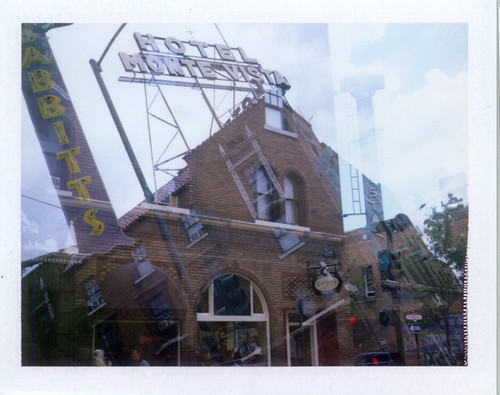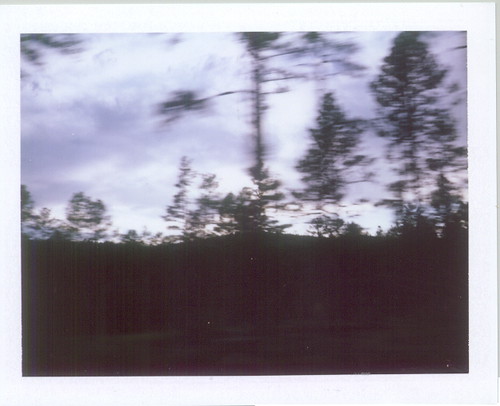Navigating the New Economy
The Outs - The Noise
January 2010
Ellen Jo Roberts

On “Black Friday,” the morning after Thanksgiving, we were nestled around a campfire, cuddling with coffee mugs to ward off the chill of the night before. We spent the holiday under the stars camped on a wild beautiful bluff overlooking the Verde River. Friends had organized an outdoor banquet, completely off the grid, but not lacking a thing. There were two turkeys, with all the traditional tubers and root side dishes, stuffing, numerous pies of assorted fruits and nuts, and a broad variety of beverages both hot and cold.
As we woke up to the day, all wild-haired and sleepy-eyed, somebody said,
“Isn’t it funny that at this very moment people are storming Super-Walmart, wrestling each other for the best deals on flat screen TVs?”
We all shook our heads, chuckling in disbelief.
The thought that people had camped out in the very same valley, the very same night, but in an asphalt parking lot waiting for “doorbuster deals,” could not have sounded more foreign to us.
Not just because we didn’t have the bucks to buy each other expensive electronics, and not just because the idea never even occurred to us — but also because frenzied spending seems a thing of the past — from a time when people spent money they didn’t have on things they didn’t need.
The current economy may be the new economy, the new normal — with the spendy memories of the not too distant past gone out like a tide that ain’t never coming back.
For us, our lives luckily have not changed too much — but, we’ve never lived large. Actually, that’s just a nice way of saying we were poor and broke before, and we’re poor and broke now. We here in Northern Arizona are well acquainted with “poverty with a view,” so for us it’s like the rest of the country is finally slowing down to our speed.
We may be on a low budget but this doesn’t mean our life isn’t rich. Our newest vehicle is 23 years old, and we don’t have any car payments. We bought a small house with a manageable mortgage. We shop local whenever possible. Many times we just go without. We seldom dine out, see movies at the show, or buy new clothing. Most everything we own is 2nd or 3rd hand. No cable TV, no satellite radio, no high-speed internet. For us, this way of life hasn’t changed much in 15 years.

This doesn’t mean we are without our extravagances.
I like a new pair of Fluevogs every few years, and ordering Fuji instant film for my old Polaroid cameras. Chad has expensive tastes in shampoo and hair wax. He indulges me the cost for art supplies, and processing 35mm film. We treat ourselves to new Levis every year, and splurge on a seasonal bottle of Bombay Sapphire gin. Perhaps our most ridiculous luxury is jetting our Chihuahua, Floyd, around with us on (rare) airplane trips.
Despite these lil’ splurges, we live cheap, filling our lives with experiences rather than expenses. We are very grateful to both still be employed, keenly aware of the many Americans who’ve spent the last few years scrambling for jobs after being downsized, out-sourced, or having their retirement savings swallowed by economic failure.

How has your life changed? In what ways have you changed your habits to navigate the new economy? How have our local communities been impacted, being heavily reliant on tourism? This is what I wanted to know. This is what I asked people. I talked to many artists and creative types who, by nature of their creativity, adapt to whatever is dished their way.
I have friends who’ve taken pay cuts, lost their jobs, and lost their homes.
But even in these tough clouds, silver linings are evident.
“People don’t think so materialistically. They think of other values in life, and live more simply,” said Verde Valley artist, Birgitta Lapides. “So, I think some good can come from it. People can realize the truly important things in life. It’s more who you are than what you have.”
Ms. Lapides shows her work in Jerome, a town that operates in its own economic micro-climate, a different planet than Every Day, USA, but still not completely immune to the ebb and tide of the outside world. Many artists who sell their work in the town have found the need to offer lower-priced series of works because the grand masterpieces are just not selling like they used to. Anne Bassett, renowned Jerome artist and longtime resident, has survived there for years, in times both lean and rich.
“I have aspired to ‘scrape by’ but not actually attained that status yet,” jokes Ms. Bassett. “I expect the US economy to get much worse as our war debt impacts are felt. Our nation's pitiful education system has lost us the edge on being global innovators in technology, and our foot-dragging on global warming has hampered our nation in green advancement, which I believe to be the only expanding financial venue around. My art income has stayed about the same for a couple decades, fluctuations not withstanding. Gold, art and real estate appreciate.”

Real estate, while generally agreed a good investment, has been troubled during recent years, with the realty boom busting big time. Denise Lerette is a realtor in the Verde Valley. She lives in a historic bungalow in Clarkdale, with her cat, Barrington, and dog, Jaeger.
“I'm not exaggerating when I tell you it has been tough,” says Ms. Lerrette, “When it hit our entire economy, it hurt in several different ways. First, of course, is the ol’ pocketbook. I learned how to live very frugally last year. I cannot stress how frugally I really mean! I had my gas turned off for 6 months. I became very adept at heating a tub, doing laundry, and other seemingly common tasks with a bare minimum of energy expended. I did not have cable or even turn on my TV. This I now like! I discovered the library and long walks with Jaeger. I latched on to a little device called a ‘Kill-A-Watt,’ thanks to a good friend in Flag, and got my APS bill down to $25 a month. It taught me a lot about conservation, tenacity, and kindness, above all.”
Ms. Lerrette sees a bright light at the end of the tunnel.
“The upside to all of this was really learning something about the varieties of human natures that do exist. Fortunately, I have not lost my faith in humanity and have seen that human kindness still outweighs its polar opposite. People working together is the only way we will truly survive and live well.”
Bethany Bezdek is a married mother of 3, living in Clarkdale.
The turbulent economy has made a profound impact on her family.
“We gave up our house because of the economy. Big change,” said Ms. Bezdek.
“I used to go to the health food store once a week. Now I go maybe once a month and buy 4 or 5 items. Our grocery bill for the five of us is always more than I think it should be, even with these changes. I grew up on government cheese and powdered milk, so I am not complaining. I still feel very fortunate to have food and to be able to buy it on my own.”
The Bezdeks no longer purchase books or magazines, and have very few meals out. And rather than going to the movies, the family enjoys free entertainment like libraries, parks and hiking. Their life remains joyful, despite the wild financial ride. “Truthfully, it feels fine,” says Ms. Bezdek, “Although I do miss just going out for Chinese on a whim. As cliché as it sounds, I have really appreciated the importance of our family and how lucky we are to love each other and enjoy each other’s company.”
Many people have changed their lives in big ways, and many make changes in small ways that add up big: killing watts and their televisions, cutting cable and internet, brown-bagging their lunches, quitting cigarettes, planning smaller vacations or “staycations.” Many donate more to charity than ever before.

“We really don't realize how spoiled we are until everything has been taken away. Like a kid getting grounded and having their phone, computer and TV taken away,” said Stacey Champion, of Phoenix.
Ms. Champion is the owner of Champion Indoors, an environmental consulting firm. A single mom raising two young children, she takes coupons seriously, and has downsized the “fluff,” like everyone’s nemesis, “Target ‘impulse’ buying.”
Says Ms. Champion, “I feel very fortunate that I grew up Midwestern and blue-collar, because when everything was really good and the money was flying in, I didn't go out and buy a new car, new house, etc. My debt load probably isn't as bad as many other people's because of this. I also take my kids to do as much volunteering and charity work as possible now, so that they can see, first-hand, that even though we aren't able to necessarily ‘do’ or buy all of the things we used to, there is still an awful lot to be thankful for — like a roof over our heads and food on the table. Small but important stuff.”
Ms. Champion, an idealist, believes good times will return, and we will get through this challenging time, “being more grateful and humble in the long run.”
Kenny Mattheis is a jack-of-all-trades, a bit of a genius, and a self-proclaimed “hobo,” who lives in a tiny but chic house in Humboldt, outside of Prescott.
“The biggest change I've had to make in my life due to cutbacks, is the amount of income I can donate to things I believe in. I'm used to giving 60 to 70% of my income to causes I feel will affect my life directly. I'm still able to give the same percentages, but 60% is a lot less these days than it's been in the past.”
Mr. Mattheis is a big fan of a website called
Instructables.com, which offers instructions and ideas for fashioning useful second lives out of assorted objects, and things people discard. “Turning some things I don't use any more into useful things I can use, or other people say that they would like, or need. I've even been able to make a little money on the side helping people with projects or making stuff that they would like to have.”
Another issue aggravated by the financial downturn is health care: the millions of citizens who don’t have it, and are farther away from it than ever. “I find myself donating more and more art for raffles or auctions to assist those without medical insurance cover their costs,” says Clarkdale artist Judy Jaaskelainen, “These are people who we might refer to as the ‘working poor.’ They are not 'poor enough' to qualify for AHCCCS or other government assistance, but they do not have the means to cover the cost of medical care.”
Ms. Jaaskelainen is currently involved in selling raffle tickets to raise money for local artist, Mary [Druen] McKeown, who needs two new hip joints. Artists, jewelry makers, and businesses have donated a great list of items. “There will be other fund-raisers on Mary's behalf in the New Year,” says Ms. Jaaskelainen, “Mary is only one of the hundreds, maybe thousands, of ‘working poor’ in and around the Verde Valley. Artists, craftsmen, and musicians seem most at risk.”
In interviewing people, I discovered restaurant meals are the expense most commonly being trimmed from budgets in this new economy.
Jet Tennant, owner of Jerome’s Mile High Grill, runs the restaurant lean, confronting the downslide head on, basing their plan of action on past seasonal successes. “We also keep a strong bare bones crew who are willing to work harder when it is busy, instead of over-staffing. We put off improvements for a year to see how we would be affected. Living in a tourist town offers us a influx of people that other places don't have,” said Ms. Tennant, “I feel like we are riding a wave. It feels a bit wild, but not out of control. Just a ride, which is why I got into the restaurant business and being self-employed in the first place.”

Sedona is one of Arizona’s top tourist destinations, and feeds dollars to all of the outlying communities. Nena Barlow operates Barlow’s Jeep Rentals in Sedona.
“We were lucky to not drop very much early in the ‘recession.’ We have worked a lot harder to make the same money,” explains Ms. Barlow. “We became more aggressive with specials, reviewed and increased our marketing efforts, and set very tight budgets to keep costs in hand.
“What I observed was that the higher-priced goods and services have been the hardest hit. If you have some product that is on the lower-end of the price spectrum for which your customers are shopping, they will still buy. Everyone is looking for a bargain, and no one is too proud to ask for specials or discounts these days. We aren't looking at this as ‘how do we survive?’ but rather ‘how do we run this leaner and meaner from now on?’ Sort of like adopting a new diet — it's not some fad, it's a necessary adjustment we need to make to stay healthy from now on.”
Bradley Blalock is a gifted singer, musician, and a licensed massage therapist, working at the ASIS Clarkdale campus. The current economy has stimulated his creativity. He spends more time practicing music and creating music at home instead of watching TV or surfing the internet. Mr. Blaylock surrounds himself with positive people, “Staying creative and positive, as best I can to live nobly through this, without self-destructively escaping into negative behaviors, one day at a time.”
Our pal Natasha Shealy, a perennial Noise favorite, offers her tips for conserving money. Ms. Shealy lives in smalltown North Carolina, a rural hardscrabble microclimate not dissimilar to our own. She is surrounded by creative people, artists, writers and musicians.
“I cut expenses, and build skills wherever possible. Perhaps a Protestant hangover, I thrill in cutting my own wood for fuel, growing our own food, and brewing homemade beer and wine. I have harvested fowl, but have yet to hunt deer. I leave that to the mountain man … I am recording my ideas for a book to share with others.”
Ms. Shealy has always been inspired by the 1970s series of Foxfire books, with mountain folk telling tales of making soap, building cabins, pickin’ tunes, and slaughtering swine. Something tells me she’d be living this lifestyle and writing about it even if she were a millionaire.

A Jeroman who wishes to remain anonymous shared her secret of success with us: “Once a week I take an hour to tour the great fortune that can be found in the charity and thrift stores of the valley. Had I known what a fun sport this was, I would have started it years ago. When I think of all the countries and cities I have traveled to and yet missed out on the random filtering of items considered surplus! The trickle-down effect of ‘one mans trash is another’s treasure.’ The sport and randomness of finds is a daily renewal on the thrift front. It’s the closest thing to gambling I have ever done ... Some days I want to run out of the store and toss my fist into the air with triumph, and do the Rumpelstiltskin jig of joy.”
I’ve long been an avid fan of thrift shops, dating way back to the year 1985, when a hip older cousin took me to scout out my neighborhood secondhand store in search of a trench coat for his New Wave ensemble. Thrift shops are chock full of housewares, artwork, office supplies, movies, books, clothing, tools, and vintage appliances manufactured better than anything made today and sold at prices well below their value.
We reevaluate the notion of “stuff.” We reexamine the products we use.
The new economy has affected us in interesting and different ways. Some of us not at all, and some for the worse. Some have actually benefited from it, due to special skills, and situations. Many of us live how our grandparents did in the Great Depression, stitching socks, surviving on soup, and growing our own food. Young people just entering the job market have no great expectations for the fantastic career, knowing their fine education now offers no guarantees. Older folks who’ve worked hard their whole lives, planning ahead like the ants for winter, now find themselves in a pickle like the goofy grasshopper, at no fault of their own. Everything’s been erased, re-written, wiped out, like a brand new ball game.
In the end, might we be better for it?
When the true value of the important things shines brighter than bling ever did?
I think you know the answer.
Ellen Jo Roberts is low on budget but high on life. She lives in a historic bungalow in Clarkdale, Arizona with “Bike Daddy” Chad, “Cool Cat” Clyde, “Five Pounds of Fury” Floyd, Ivan a.k.a. “Goofy McSuper-Spaz” and several ancient automobiles.
Read all about it at ellenjo.com




















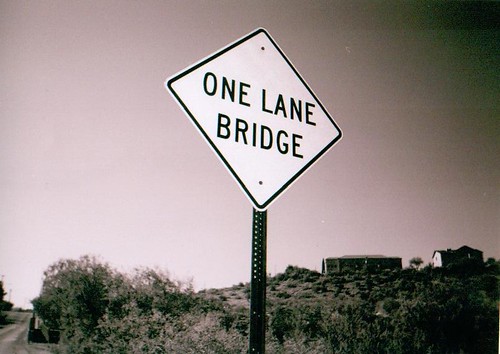

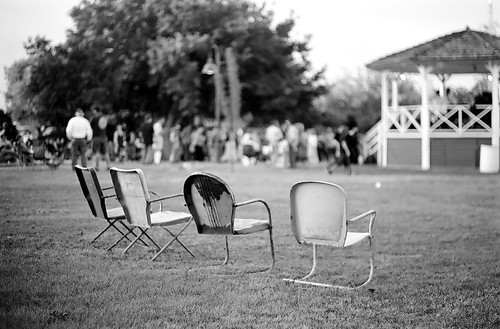

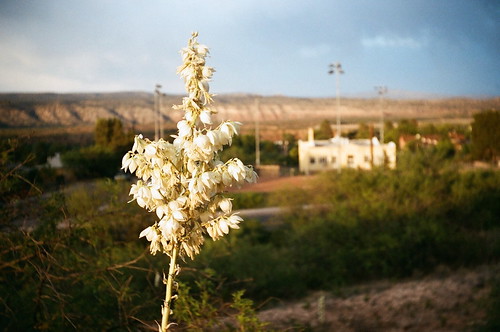





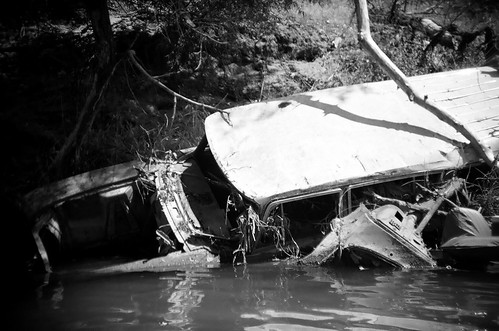

 Tim and Ruth made us a delicious dinner on the barbecue, and that night we all sleep like rocks.
Tim and Ruth made us a delicious dinner on the barbecue, and that night we all sleep like rocks.